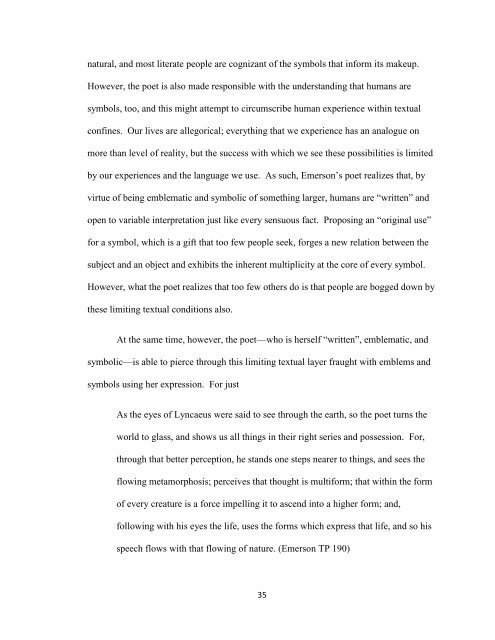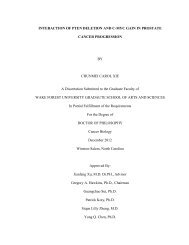RALPH WALDO EMERSON AND THE EVER-EVOLVING ART OF ...
RALPH WALDO EMERSON AND THE EVER-EVOLVING ART OF ...
RALPH WALDO EMERSON AND THE EVER-EVOLVING ART OF ...
Create successful ePaper yourself
Turn your PDF publications into a flip-book with our unique Google optimized e-Paper software.
natural, and most literate people are cognizant of the symbols that inform its makeup.<br />
However, the poet is also made responsible with the understanding that humans are<br />
symbols, too, and this might attempt to circumscribe human experience within textual<br />
confines. Our lives are allegorical; everything that we experience has an analogue on<br />
more than level of reality, but the success with which we see these possibilities is limited<br />
by our experiences and the language we use. As such, Emerson’s poet realizes that, by<br />
virtue of being emblematic and symbolic of something larger, humans are “written” and<br />
open to variable interpretation just like every sensuous fact. Proposing an “original use”<br />
for a symbol, which is a gift that too few people seek, forges a new relation between the<br />
subject and an object and exhibits the inherent multiplicity at the core of every symbol.<br />
However, what the poet realizes that too few others do is that people are bogged down by<br />
these limiting textual conditions also.<br />
At the same time, however, the poet—who is herself “written”, emblematic, and<br />
symbolic—is able to pierce through this limiting textual layer fraught with emblems and<br />
symbols using her expression. For just<br />
As the eyes of Lyncaeus were said to see through the earth, so the poet turns the<br />
world to glass, and shows us all things in their right series and possession. For,<br />
through that better perception, he stands one steps nearer to things, and sees the<br />
flowing metamorphosis; perceives that thought is multiform; that within the form<br />
of every creature is a force impelling it to ascend into a higher form; and,<br />
following with his eyes the life, uses the forms which express that life, and so his<br />
speech flows with that flowing of nature. (Emerson TP 190)<br />
35




